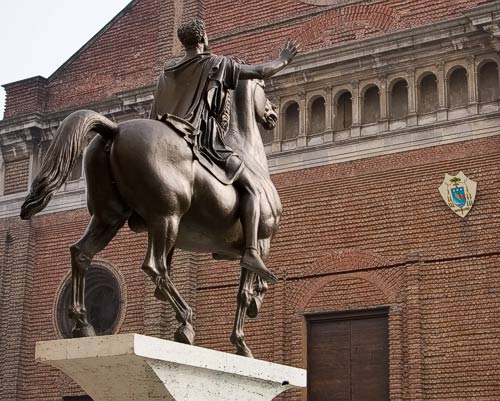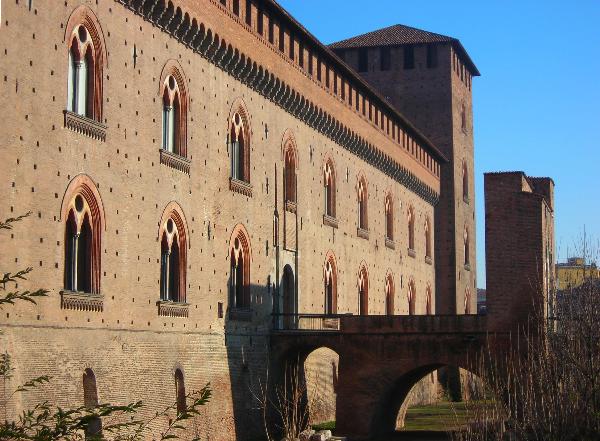Team:UNIPV-Pavia/Pavia/Past
From 2010.igem.org
| (2 intermediate revisions not shown) | |||
| Line 20: | Line 20: | ||
A late name of the city in Latin was Papia (probably related to the Pope), which evolved to the Italian name Pavia. Sometimes it's been referred to as Ticinum Papia, combining both Latin names.<br> | A late name of the city in Latin was Papia (probably related to the Pope), which evolved to the Italian name Pavia. Sometimes it's been referred to as Ticinum Papia, combining both Latin names.<br> | ||
Under the <b>Goths</b>, Pavia became a fortified citadel and their last bulwark in the war against Belisarius. | Under the <b>Goths</b>, Pavia became a fortified citadel and their last bulwark in the war against Belisarius. | ||
| - | After the Lombards conquest, Pavia became the capital of their kingdom (AD. 568-774). During the Rule of the Dukes, it was ruled by Zaban. It continued to function as the administrative centre of the kingdom, but by the reign of Desiderius, it had deteriorated as a first-rate defensive work and Charlemagne took it in the Siege of Pavia (June, 774) assuming the kingship of the Lombards. Pavia remained the capital of the Italian Kingdom and the centre of royal coronations until the diminution of imperial authority there in the twelfth century. In 1004 Henry II, Holy Roman Emperor bloodily suppressed a revolt of the citizens of Pavia, who disputed his recent crowning as King of Italy.<br> | + | After the Lombards' conquest, Pavia became the capital of their kingdom (AD. 568-774). During the Rule of the Dukes, it was ruled by Zaban. It continued to function as the administrative centre of the kingdom, but by the reign of Desiderius, it had deteriorated as a first-rate defensive work and Charlemagne took it in the Siege of Pavia (June, 774) assuming the kingship of the Lombards. Pavia remained the capital of the Italian Kingdom and the centre of royal coronations until the diminution of imperial authority there in the twelfth century. In 1004 Henry II, Holy Roman Emperor bloodily suppressed a revolt of the citizens of Pavia, who disputed his recent crowning as King of Italy.<br> |
In the 12th century Pavia acquired the status of a self-governing commune. In the political division between Guelphs and Ghibellines that characterizes the <b>Italian Middle Ages</b>, Pavia was traditionally Ghibelline, a position that was as much supported by the rivalry with Milan as it was a mark of the defiance of the Emperor that led the Lombard League against the emperor Frederick Barbarossa, who was attempting to reassert long-dormant Imperial influence over Italy.<br> | In the 12th century Pavia acquired the status of a self-governing commune. In the political division between Guelphs and Ghibellines that characterizes the <b>Italian Middle Ages</b>, Pavia was traditionally Ghibelline, a position that was as much supported by the rivalry with Milan as it was a mark of the defiance of the Emperor that led the Lombard League against the emperor Frederick Barbarossa, who was attempting to reassert long-dormant Imperial influence over Italy.<br> | ||
[[Image:UNIPV_Pavia_Castello_Visconteo2.JPG|thumb|Visconti Castle]] | [[Image:UNIPV_Pavia_Castello_Visconteo2.JPG|thumb|Visconti Castle]] | ||
In the following centuries Pavia was an important and active town. Under the Treaty of Pavia, Emperor Louis IV granted during his stay in Italy the Palatinate to his brother Duke Rudolph's descendants. Pavia held out against the domination of Milan, finally yielding to the <b>Visconti family</b>, rulers of that city in 1359; under the Visconti Pavia became an intellectual and artistic centre, being the seat from 1361 of the [[Team:UNIPV-Pavia/Pavia/Athenaeum|University of Pavia]] founded around the nucleus of the old school of law, which attracted students from many countries.<br> | In the following centuries Pavia was an important and active town. Under the Treaty of Pavia, Emperor Louis IV granted during his stay in Italy the Palatinate to his brother Duke Rudolph's descendants. Pavia held out against the domination of Milan, finally yielding to the <b>Visconti family</b>, rulers of that city in 1359; under the Visconti Pavia became an intellectual and artistic centre, being the seat from 1361 of the [[Team:UNIPV-Pavia/Pavia/Athenaeum|University of Pavia]] founded around the nucleus of the old school of law, which attracted students from many countries.<br> | ||
| - | <b>The Battle of Pavia (1525)</b> marks a watershed in the city's fortunes, since by that time, the former cleavage between the supporters of the Pope and those of the Holy Roman Emperor had shifted to one between a French party (allied with the Pope) and a party supporting the Emperor and King of Spain Charles V. Thus during the <b>Valois-Habsburg Italian Wars</b>, Pavia was naturally on the Imperial (and Spanish) side. The defeat and capture of king Francis I of France during the battle ushered in a period of <b>Spanish occupation</b> which lasted until 1713 at the | + | <b>The Battle of Pavia (1525)</b> marks a watershed in the city's fortunes, since by that time, the former cleavage between the supporters of the Pope and those of the Holy Roman Emperor had shifted to one between a French party (allied with the Pope) and a party supporting the Emperor and King of Spain Charles V. Thus during the <b>Valois-Habsburg Italian Wars</b>, Pavia was naturally on the Imperial (and Spanish) side. The defeat and capture of king Francis I of France during the battle ushered in a period of <b>Spanish occupation</b> which lasted until 1713 at the conclusion of the War of the Spanish Succession. Pavia was then ruled by the <b>Austrians</b> until 1796, when it was occupied by the French army under <b>Napoleon</b>. During this Austrian period the University was greatly supported by Maria Theresa of Austria and saw a great renaissance that eventually led to a second renaissance due to the presence of leading scientists and humanists like [[Team:UNIPV-Pavia/Pavia/Vip #Alessandro Volta|Alessandro Volta]], [[Team:UNIPV-Pavia/Pavia/Vip #Lazzaro Spallanzani|Lazzaro Spallanzani]], [[Team:UNIPV-Pavia/Pavia/Vip #Camillo Golgi|Camillo Golgi]] among others.<br> |
In 1815, it again passed under Austrian administration until the <b>Second War of Italian Independence (1859)</b> and the <b>unification of Italy</b> one year later. | In 1815, it again passed under Austrian administration until the <b>Second War of Italian Independence (1859)</b> and the <b>unification of Italy</b> one year later. | ||
</td> | </td> | ||
| Line 32: | Line 32: | ||
<td align="left" valign="top" width="15%"> | <td align="left" valign="top" width="15%"> | ||
| - | <table border="0" width="100%" height="100%"> | + | <table border="0" width="100%" height="100%" class="menu"> |
<tr align="right"><td height="15"> | <tr align="right"><td height="15"> | ||
[[Team:UNIPV-Pavia/Pavia|PAVIA]] | [[Team:UNIPV-Pavia/Pavia|PAVIA]] | ||
Latest revision as of 22:47, 25 October 2010
|
|
|||||||||||||||||||
|
|
|
|||||||||||||||||
 "
"


